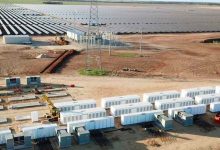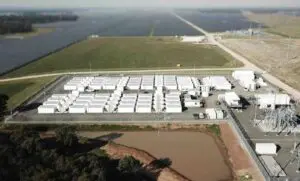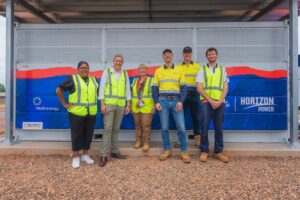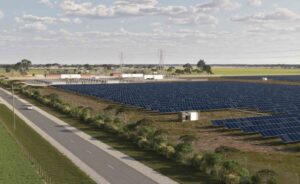It’s a shame the second wave of big batteries about to join Australia’s main grid did not come with Elon Musk’s 100-day-or-its-free promise. Had they done so, the country might have been about to benefit from a lot of free storage!
There’s no doubt that strings were pulled to ensure that the Tesla big battery, located next to Neoen’s Hornsdale wind farm in South Australia, was up and running by the December 1 deadline last year, and well within the 100-day promise.
In Victoria, two other big batteries that were tendered around the same time as the big battery in South Australia have finally begun the commissioning process, and should be on-line in time for the official start of this summer, December 1.
Both the Gannawarra Energy Storage System and the Ballarat Energy Storage System (GESS and BESS) are likely to play a critical role in helping the Australian Energy Market Operator manage the grid in Victoria, particularly given forecasts of a hot dry summer and stresses on thermal generation.
So, too, will the new Dalrymple North battery storage facility on South Australia’s Yorke Peninsula.
RenewEconomy understands the 30MW/30MWh Ballarat battery, uniquely located in a network junction hosted by Ausnet, has begun commissioning and has been operating at a preliminary level of 5MW, with tests at higher ratings to follow soon.
The 25MW/50MWh Ganawarra battery, located next to the 50MW solar farm of the same name, is also poised to begin its commissioning process, RenewEconomy understands, while the 30MW/8MWh Dalrymple North battery in South Australia is in the final stages of that process, having already tested its islanding feature, as we reported here.
Both the Gannawarra and the Ballarat batteries have received significant funding from the Victorian government and the Australian Renewable Energy Agency – $25 million out of $34.7 million cost in the case of Ganawarra, and $25 million out of the $35 million cost in the case of Ballarat.
The need for such hefty funding from government institutions points to the cost of the battery storage technology – which still has some way to fall – and the fact that Australia’s electricity markets still have some way to travel before they unlock the full value of battery storage.
The Tesla big battery at Hornsdale forged its own path by landing a $4 million-a-year contract with the South Australia government to provide emergency back-up and grid security, and also carved a profitable niche in the local frequency and ancillary services market, as well as making some money arbitraging the market by charging at low prices and selling at high.
The juiciest part of the FCAS market has now been removed, ironically because the presence of the battery – and its speed, accuracy and versatility – meant that AEMO could ditch a grid constraint that had been outrageously gamed by the big gas generators before the arrival of battery.
The Victorian big batteries – made by Tesla in the case of Ganawarra and Fluence in the case of Ballarat – will also have to forge their own path to a sustainable business model, although it’s going to be complicated.
Both batteries will be operated by EnergyAustralia, which will pay each storage installation an undisclosed annual fee. How the batteries are used will depend partly on AEMO’s requirements, partly on local constraints, and partly on how they fit into EA’s broader portfolio strategy.
Andrew Stiel, the head of markets and off-take at Edify Energy, which is the majority owner of the Gannawarra battery, gave some insight into the challenges at the recent All Energy conference in Melbourne.
Stiel noted that because Ganawarra was a “retrofit”, use of the battery would be limited by the fact the local sub-station was rated at 50MW, the same as the rated capacity of the solar farm. That means the battery won’t be exporting while the solar farm is going full throttle.
Batteries are a smart move for existing solar farms, however, because most substations built for solar projects are only used for eight hours a day. That leaves some hefty infrastructure investments that could be used more effectively, Stiel noted.
There are also issues around dispatch. The solar farm is a “semi-scheduled” generator, while the battery is a “scheduled” generator, meaning that it is fully under the direction of AEMO’s market management. Making both assets fully scheduled is problematic for a bunch of reasons.
Stiel suggests a new category that encompasses battery storage – its limitations and opportunities – should be developed. “I think the rules need to be changed there – and introduce new classifications to unlock this value.”
That’s not an isolated gripe. Tesla has pointed out that many of its services – super-fast and accurate response to system faults that have been hailed by the market operator – don’t actually get rewarded under the current market structure.
Much needs to be done to bring the rules and operating structure into the 21st century to reflect the rapid changes in technology, as AEMO itself has acknowledged.

The Ballarat system is unique in that is joined into a key network junction rather than a renewable energy facility, and will act in a number of different roles – including helping unlock the network constraint in a region that has limited network capacity but faces proposals for up to 4000MW of wind and solar.
It will operate 24/7 to support critical peak demand and frequency control services. “It is an asset that is designed to support all stakeholders along that corridor,” Fluence’s head of business development Jaad Cabbabe told the All Energy conference.
The battery at Dalrymple, which an ElectraNet spokesman says is in the final stages of commissioning, after what seems to be an incredibly drawn out process (it was supposed to be on-line months ago), has a different role again.
Like the others, it will be able to provide grid services such as FCAS, but in its case it will also be able to create a micro-grid, and use neighbouring wind power (it is situated next to the Wattle Point wind farm) and local rooftop solar resources to ensure local supply is maintained, even if the grid is down elsewhere.
And then it will be the turn of a third wave of big batteries to join the grid, and continue the transition towards 100 per cent renewables, with a Tesla battery at the Kennedy wind-hybrid project in Queensland, and a 25MW/52MWh Tesla battery at the existing Lake Bonney wind farm in South Australia currently under construction.
These will be followed by the 20MW/34MWh battery at the Bulgana renewable hub near Stawell, Victoria, as well as the 10MW/10MWh battery at the Lincoln Hill Gap wind farm, and a 21MW/26MWh battery next to a solar farm addition to the Snowtown wind farm in South Australia.
And these are just the confirmed ones. Numerous other large-scale wind and solar projects are also looking to battery storage – and will likely go ahead with some clarity over market rules, energy policy, and network infrastructure. And, of course, there is pumped hydro and any number of “distributed” storage installations.










